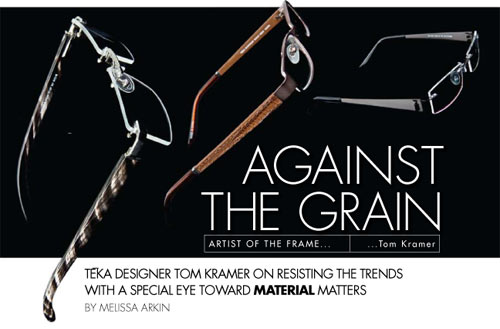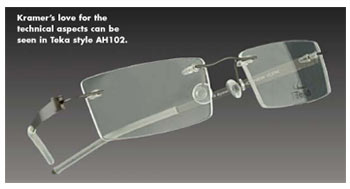
 For the past two consecutive Vision Expo shows, the Vision Choice award for Best New Product has been bestowed upon optical newcomer Tom Kramer, founder and designer of Teka Eyewear. This honor celebrates highly innovative eyewear in terms of both design and technology. Kramer, whose company has only been around since 2007, has come a long way in just three years.
For the past two consecutive Vision Expo shows, the Vision Choice award for Best New Product has been bestowed upon optical newcomer Tom Kramer, founder and designer of Teka Eyewear. This honor celebrates highly innovative eyewear in terms of both design and technology. Kramer, whose company has only been around since 2007, has come a long way in just three years.
Teka Eyewear (pronounced “tee-KAY” to represent the designer’s initials) is a collection built on passion. Designed entirely by Kramer, many Teka frames employ unique and exotic materials, which he loves to work with. “The materials for my frames are sourced from all over the world,” he says. “I have a frame that is made with bubinga wood, a rare wood from Africa. And there’s another made from zebrawood, a wood I have never seen used in eyewear before. We find small boutique factories that specialize in dealing with these materials. These woods are not stained; there is no wood veneer. If you were to break it open it would be the same wood inside as it is outside.”
Tapping into natural resources to create eyewear does not stem from an urge to embrace any current trend; the usage of woods, buffalo horn and leather derives from Kramer’s love for nature. “You look around and see trees, plants, fish and birds and they’re just beautiful,” he says. “I’d love to use a fish skin on a pair of glasses, but unfortunately you can’t do that. You have things appearing in nature that are perfect the way they are.”
Dismissing current trends and embracing his own style isn’t just a matter of aesthetic for Kramer, but also a well-devised business model. The timelessness of the collection, which is geared toward wearers aged 25 and up, ensures an enduring shelf life (pun intended). “The vision of the company is to provide timeless eyewear—not something that is here today, gone tomorrow fashion,” says Kramer. “Salespeople at optical shops get a feel for the frames’ shapes and contours. This differs from another model of selling frames, which involves coming out with a lot of new styles and being up-to-date with fashion. That may work at first, but those frames will never sell twice. I’ve seen the sales increase with Teka frames over time because salespeople have more confidence in the product after they’ve sold it a few times.”
Kramer’s aspiration to create timeless frames is executed through clean lines and a lot of rimless styles. “Rimless never went away,” he says. “If you look back at any of the classic frames throughout history, they are rimless and anyone can wear them. Also, since I use a lot of exotic materials on the temple pieces, I design the temple pieces first and then work my way in. I’ve always liked a clean look but you need to add a tinge of something to make it really stand out.”
In this economy, beauty alone is a hard selling point. Yet, despite the often expensive price tags on the rare materials, Kramer has a unique approach to business that makes the collection rather accessible. “The way I look at my business is not the way most people approach their business,” he explains. “I don’t look at the exact cost and say I need to make an exact amount of money on a particular frame. I balance cost over the entire collection. There are some frames that I don’t make much of a profit on but I sell at a lower price just so I can get it out there. For example, even though we offer some pieces in the collection with much more buffalo horn on them than others, we keep the price point the same so that we can keep on selling the frames well.”
 For someone who seems to have both the design and marketing sides of his company worked out so thoroughly, it may come as a surprise that Kramer didn’t have any experience in the optical industry until just a few years ago. It was a combined interest in fashion and fascination for the technical aspects of construction that drew him to eyewear design. “I’ve always loved taking the ordinary and turning into something else,” he says. “I enjoy fashion along with the hands-on aspects, like finding out exactly how the screws are made and learning about grooves. I love the manufacturing part of the trade, and you’ll see a lot of that in the Teka metal and plastic frames—I’ll take a functional element like a hinge and turn it into an architectural piece.”
For someone who seems to have both the design and marketing sides of his company worked out so thoroughly, it may come as a surprise that Kramer didn’t have any experience in the optical industry until just a few years ago. It was a combined interest in fashion and fascination for the technical aspects of construction that drew him to eyewear design. “I’ve always loved taking the ordinary and turning into something else,” he says. “I enjoy fashion along with the hands-on aspects, like finding out exactly how the screws are made and learning about grooves. I love the manufacturing part of the trade, and you’ll see a lot of that in the Teka metal and plastic frames—I’ll take a functional element like a hinge and turn it into an architectural piece.”
Despite Kramer’s affinity for the design process, he makes sure to always take the wearer into consideration. “When I design a frame, it’s not just a design piece,” Kramer explains. “First I look at someone’s face and think of what I can do to enhance that face. I never try to hide anyone’s features. I begin the design process by assessing what type of shape or what kind of material will make the most of someone’s face.”
Kramer puts a lot of emphasis on understanding the Teka customer. Taking the feedback from his clientele, the line has evolved along the way. “I always listen to feedback and learn,” says Kramer. “I always stick to the image of the brand and the process won’t change, but customer input has influenced some of the styles. The combination of colors on one of the wood frames is based on a suggestion I got from a customer.”
There is more for Teka Eyewear on the horizon. The success of the past three years has encouraged Kramer to branch out and look into a sunwear line and possibly even acquire a license for a children’s collection. “I’m always thinking about what’s going to be next,” he says.











